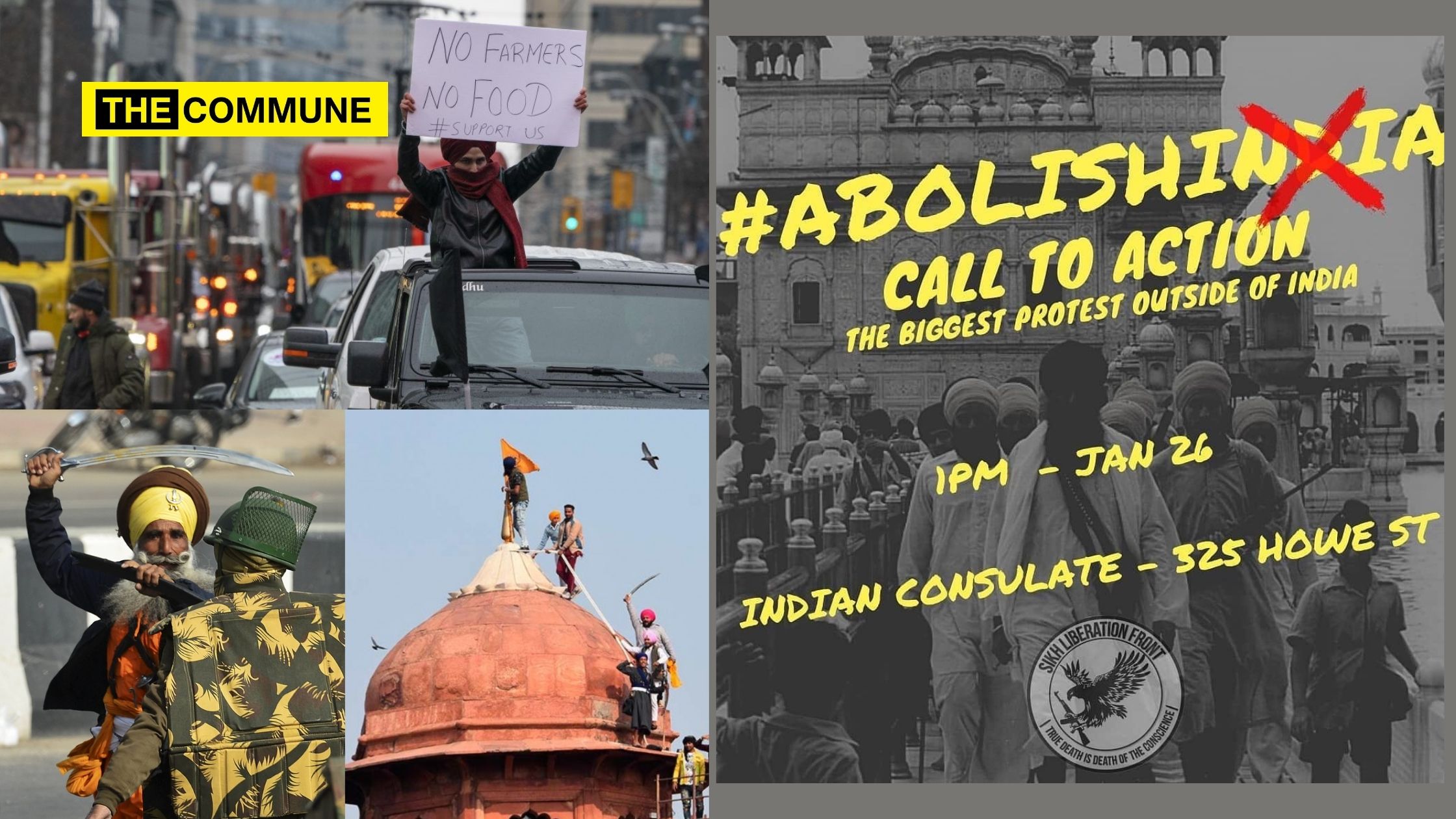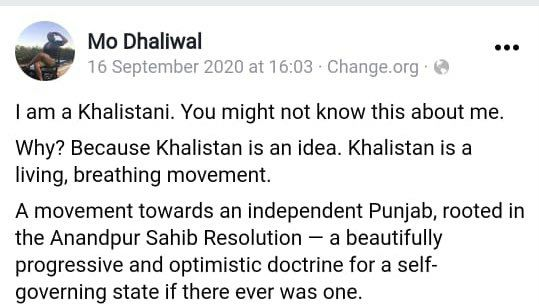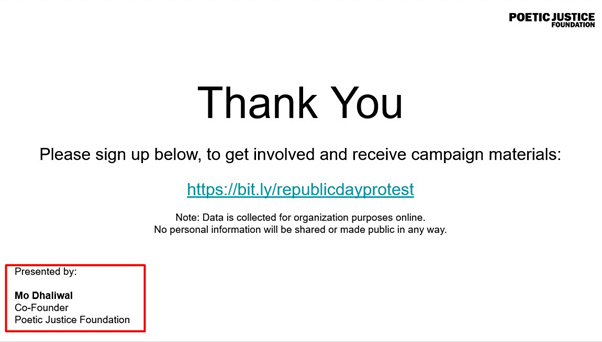
Protesters gathered in downtown Vancouver on Tuesday January 26 for what they called a “Global Day of Action”. Coincidentally, the day of the protests in Canada did coincide with the tractor rally and the ensuing riots that shook India’s capital. On 26 January 2021, Republic day, agitators protesting the Centre’s farm laws took out a massive tractor rally in Delhi. However, the rally soon turned violent and the agitators ran riot on the streets of the national capital. They destroyed cement barriers and police barricades, attacked security forces with swords and caused great destruction to Delhi’s public property. While some rioters rode horses and tried to run down policemen, others attempted trample policemen under tractors.


However, it is not just the day of the protest at Vancouver that connects it to the riots in India. The protests were held outside the Indian consulate on Tuesday in support of agitating farmers in India.



One of the groups behind the protests is called Our Avaaz. The group has been organizing local protests in Metro Vancouver, in solidarity with the violent agitators who planted Sikh and Khalistani flags on top of the Red Fort in Delhi. According to the organizers, similar rallies in support of farmers have been taking place “in Canada, the United States, Australia, the UK, Germany and Denmark to bring attention to India’s history of oppressive actions as vulnerable farmers and their families continue to protest in Delhi.”
#AskIndiaWhy
In a statement, a spokesperson for Our Avaaz said that “the focus of today’s protests was to mark a Global Day of Action, which would encourage global citizens and the Indian diaspora to #AskIndiaWhy”.
“This hashtag will connect efforts by supporters around the world to keep India accountable for human rights abuses and to highlight that global attention is turned to the farmer protest in Delhi with the expectation of a peaceful resolution.”
While one wonders what human rights abuses the Canadian protestors are talking about, one must also note that this is the same hashtag mentioned under the ‘prior actions’ list in the ‘toolkit’ document that was earlier shared by Swedish radical Greta Thunberg. The now-altered document had called for a ‘Digital Strike’ and a ‘Global TweetStorm’ by trending #AskIndiaWhy and tagging the Twitter handles of the PMO, the Agriculture Minister, other Indian government officials and press-persons.
This coincidence of the hashtag can be explained by the fact that another group involved in the Vancouver protest was the Poetic Justice Foundation (PJF), and the PJF is the group that created the ‘toolkit’ document and other campaign materials and social media templates to frame the farmers’ agitations in a particular narrative.
According to the group’s website (the website being registered in Germany): “Poetic Justice Foundation challenges structures of oppression and discrimination through intersectional grassroots advocacy. We develop content, workshops and events to provoke, challenge and disrupt systemic inequities and biases. We create safe spaces for exploration, learning and healing to foster societal change. Our goal is to educate, organize and mobilize Canadians to achieve and protect equal rights in all aspects of social, political and economic life.”
The website also adds: “Currently, we are most actively involved in the #FarmersProtest that has activated Indian diaspora worldwide as a rebuke to India’s oppressive policies towards farmers.”
There is also a website AskIndiaWhy.com, registered to a UK address. This website is owned by PJF.
Mo Dhaliwal: The PJF’s front-man
Talking of the protests in Vancouver, Mo Dhaliwal, co-founder of the Poetic Justice Foundation, stated in a press release, “These protests might feel like they are worlds away, but they are fighting for the same things we all value here at home – including the right to earn a living and feed our families. Farmers believe the agricultural reform laws introduced by the Indian government will drive down crop prices, devastate their earnings and allow private players to dictate food prices, driving small farmers even further into debt. Their concerns must be heard and their right to peacefully protest must be protected.”
According to data available with Corporations Canada, Canada’s federal corporate regulator, Monminder Singh Dhaliwal, Hardeep Singh Sahota and Sabrina Sohi are the three directors of PJF. Dhaliwal, who runs Skyrocket, a digital marketing agency, is also a friend and brand manager of Canadian MP Jagmeet Singh Dhaliwal. He even designed Jagmeet Singh’s campaign for the 2017 leadership of the federal New Democratic Party. Jagmeet Singh is known for his Khalistani sympathies and his endorsement of violence as a tool to achieve political goals. He had even been denied a visa to India in the past.

Now, by his own admission, Mo Dhaliwal is a ‘Khalistani’ and wants “an independent Punjab”.

Did the ‘Global Left’ use the Sikh diaspora to undermine India, or is it the other way round?
Dhaliwal also gave an interview to Canadian broadcaster Global News in the aftermath of the Republic Day riots, wherein he made accusations of fascism against the Indian government, and expressed hope that there would be enough international pressure on the government to force it to repeal the farm laws. He also mentioned the role of the Sikh diaspora in creating international awareness to put pressure on India.
Moreover, these rallies are not in any way recent, and nor are they limited to Canada alone. Under the umbrella of the California Sikh Youth Alliance (CSYA), Sikh activists in California, USA celebrated the Republic Day riots and also clashed with activists of the Hindu American Foundation recently. They also opposed the re-installation of a vandalised statue of MK Gandhi.
To go back farther, in November 2020, a rally was held in Surrey in support of agitating farmers in India. Rallies were also held in Vancouver, Toronto and Calgary in Canada in December 2020.







Special mention must be made of the placards and the Sikh insignia used by those protesting against the Indian government’s farm laws. The phrase “Free Punjab” occurs more than once, on the placards attached to the windscreen of the cars participating in protest-rallies across Canada. The black jackets of two protestors shows the Khanda, a Sikh symbol, merged with the red maple leaf, a widely used national symbol of Canada. The words “Legendary Sikh Riders” are emblazoned on the jackets as well. Perhaps these protestors see themselves as a modern version of the sword-wielding, horse-riding Nihang Sikhs, generally identified as the “warriors of Sikhism”, who attacked Indian policemen during the riots in Delhi.
What all these rallies have in common is that the global Sikh diaspora play a huge role in organising them. That is very telling.
Where does the Sikh diaspora stand?
In some sort of protestors’ manual and ‘strategy deck’ released by the PJF, called “Global Day of Action: Protesting for Farmers on India’s Republic Day January 26, 2021”, it is clearly mentioned that the organisation aims “to develop a campaign in the Diaspora to support the people and the cause that awoke us.”


In another page of the ‘strategy deck’, the PJF clearly says that the support to the protests from the Sikh and Punjabi diaspora is seen as “extremism of militant factions”. There is also some lament that while “communities worldwide [are] engaged in protest actions to drive awareness”, the “Indian liberals and urbanites aren’t fully expressing their support”.
In a notable SWOT analysis of the movement in the same document, the PJF expresses the sentiment that “being overtly Khalistani” may be a bad thing as they enjoy “goodwill with [the] common people of India”.
More remarkably, the document notes that “social media activism in the west” and “mainstream media accessibility” are opportunities, seemingly with the view that such activism from Western celebrities on mainstream media (and perhaps also social media) can be exploited to force the Indian government to repeal the farm laws. “Volunteerism” and “seva” are mentioned as well, in what may possibly be a reference to the langars the Sikh community is famous for.

The document further calls for a “united global disruption in the Diaspora on Jan 26th”. Was this “disruption” the riots that happened in Delhi, or something else entirely, is not fully ascertained.

The document also contains samples of messages on how protestors and other supporters can frame the narrative. It also claims that the Indian government “persistently” “oppress[es] its citizens in favour of corporate interests”, “persecute[s] critics” and “harass[es] journalists”. Here, the document is clearly signalling to the widely-held belief among several members of the international community and a section of the Indian populace that the Indian government is some sort of authoritarian regime.

The document also explicitly mentions that through these protests, the PJF aims to “develop a compelling message for the world to take notice of India’s ongoing oppression of its citizens.”

The document also asks protestors to “access” networks of Sikh organisers and Punjabi cultural groups to influence policy makers, other social and political movements and the general public.

One section asks protestors to target “Indian consulates or intersections or community gathering places in major metros”; in other words, places related to the Indian government and/or places where lots of people can notice the protests. It is noteworthy that the site of the anti-CAA Shaheen Bagh protest too was a major traffic intersection with heavy footfall. Another interesting section of the document is called “The Plan”. This section is mostly devoted to media management and how to garner good PR for the protests.


Mo Dhaliwal is listed at the end of the document.

The PJF has also released a document for the benefit of the protestors, highlighting a few templates for social media.


The template also contains the picture, Twitter handle and a tweet by Thenmozhi Soundararajan, of the Equality Labs initiative. Equality Labs is a well-known Periyarite organisation seeking to foment hatred towards Hindus and Brahmins.


Given that the motive of the protests ― both within India and abroad ― is to de-legitimise the current Indian administration in the eyes of the world, one can only wonder what steps, if at all any, the Indian government will take to ensure that such an attempt does not succeed.
Click here to subscribe to The Commune on Telegram and get the best stories of the day delivered to you personally.




